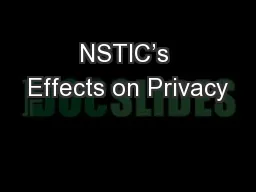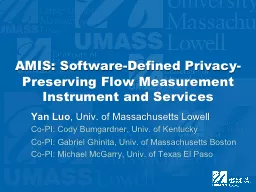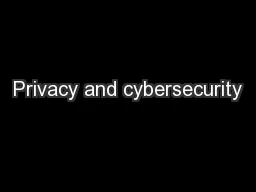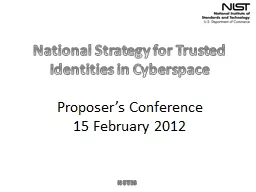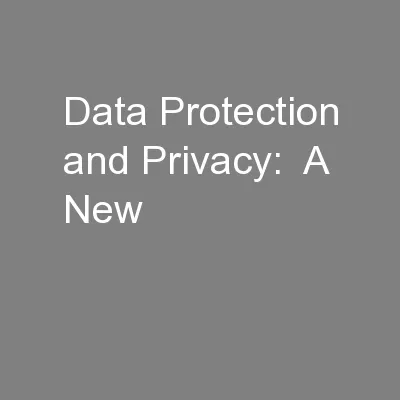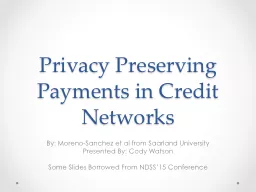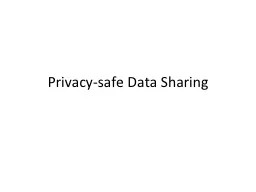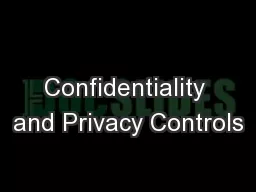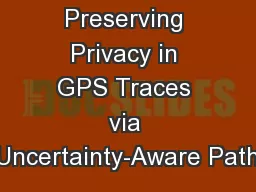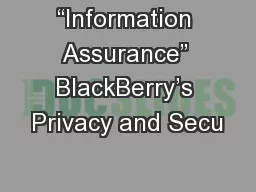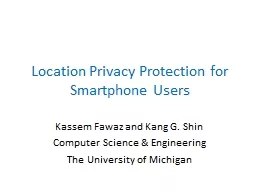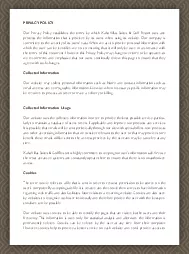PPT-NSTIC’s Effects on Privacy
Author : alida-meadow | Published Date : 2015-11-11
The Need to Balance Identity and PrivacyProtection with Market Forces in the National Strategy for Trusted Identities in Cyberspace Supplement Presented by Aaron
Presentation Embed Code
Download Presentation
Download Presentation The PPT/PDF document "NSTIC’s Effects on Privacy" is the property of its rightful owner. Permission is granted to download and print the materials on this website for personal, non-commercial use only, and to display it on your personal computer provided you do not modify the materials and that you retain all copyright notices contained in the materials. By downloading content from our website, you accept the terms of this agreement.
NSTIC’s Effects on Privacy: Transcript
The Need to Balance Identity and PrivacyProtection with Market Forces in the National Strategy for Trusted Identities in Cyberspace Supplement Presented by Aaron Titus Esq Chief Privacy Officer. Yotam. . Aron. Table of Contents. Introduction. Differential Privacy for Linked Data. SPIM implementation. Evaluation. Contributions. Theory: how to apply differential privacy to linked data.. Implementation: privacy module for SPARQL queries.. CS 656 Spring 2009. Should We Be Worried?. Medical Records Misuse. Burlington Northern allegedly conducted genetic tests on employees who had filed worker’s compensation claims for carpal tunnel syndrome, without their knowledge. The company’s intention was presumably to be able to reject some claims because of genetic predisposition to the condition.. Yan Luo. , Univ. of Massachusetts Lowell. Co-PI: Cody . Bumgardner. , Univ. of Kentucky. Co-PI: Gabriel . Ghinita. , Univ. of Massachusetts Boston. Co-PI: Michael . GPD. Purpose of this webinar. To discuss the meaning of privacy in a cyber security and human rights frame. To explore how the notion and realization of privacy . is . changed by the internet. To identify the . . Proposer’s Conference. 15 February 2012. Agenda. 9:00 Welcome and Introduction. 9:15 NSTIC Overview and Status Update. . Jeremy Grant, Senior Executive Advisor for Identity Management . 9:45 Pilots Program – Purpose and Scope. Paradigm. Richard Spires . June 23, 2015. Data Protection and Privacy: A New Paradigm. 2. Resilient . Network. Systems. . – All Rights Reserved. Existing . security/identity models are inadequate:. By: Moreno-Sanchez et al from Saarland University. Presented By: Cody Watson. Some Slides Borrowed From NDSS’15 Conference. What is a Credit . Network?. Weighted directed graph used to represent credit. CS408-01 Final Paper Presentation. By: Christina Sulfaro . Privacy Lost . Privacy Lost: How Technology is Endangering Your Privacy. The author is David H. . Holtzman. Published in 2006. Book Overview . Why Share Data?. Hospitals share data with researchers. Learn about disease causes, promising treatments, correlations between symptoms and outcomes. Merchants share data with advertisers/researchers/public. Chapter 9. 9-. 1. Learning Objectives. Identify and explain controls designed to protect the confidentiality of sensitive information.. Identify and explain controls designed to protect the privacy of customers’ personal information.. B. Hoh, M. . Gruteser. , H. . Xiong. , and A. . Alrabady. . ACM CCS. Presented by . Solomon Njorombe. Abstract. Motivation. Probe-vehicle automotive monitoring systems. Guaranteed anonymity in location traces datasets. Bandar . M.Khaleel. 200600279. Telecommunication . Outline . Introduction. Objectives. Smart Phones Family Features and Specification. Blackberry. ’. s Unique Features . BlackBerry and legality issues. Kassem. . Fawaz. and Kang G. Shin. Computer Science & Engineering. The University . of Michigan. Location-aware Apps. Location-aware mobile devices. iPhone 6, Galaxy S5 …. Location-Based Services. information from the user o their computer unless the user decides to provide it directly Users can accept or deny the use of cookies however most browsers automatically accept cookies as they serve t
Download Document
Here is the link to download the presentation.
"NSTIC’s Effects on Privacy"The content belongs to its owner. You may download and print it for personal use, without modification, and keep all copyright notices. By downloading, you agree to these terms.
Related Documents

